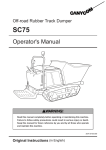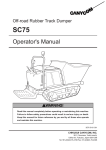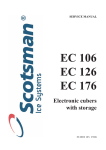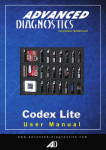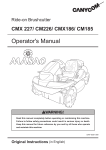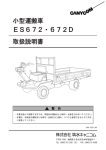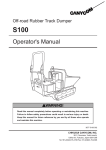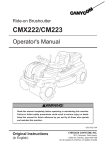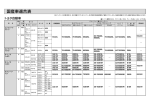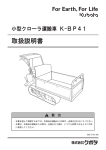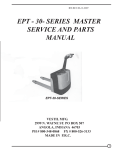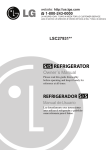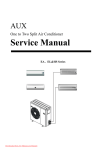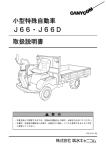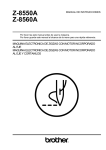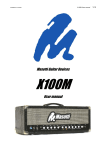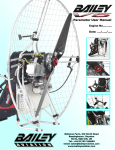Download Operator`s Manual
Transcript
4 - Wheel Utility Vehicle J 66 Operator's Manual Read this manual completely before operating or maintaining this machine. Failure to follow safety precautions could result in serious injury or death. Keep this manual for future reference by you and by all those who operate and maintain this machine. 3729 6102 000 http://www.canycom.co.jp/ 90-1 Fukumasu, Yoshii-machi, Ukiha-shi, Fukuoka, Japan 839-1396 Sales Headquarters (International) TEL +81-(0)943-75-2195 FAX +81-(0)943-75-4396 Authorized Dealer All rights reserved. Unauthorized use or reproduction of this material is prohibited. Notice to Users and Maintenance Personnel Thank you for purchasing this machine. This manual provides information needed for safe and effective use of this machine to those who operate or maintain this machine. Make sure to read and understand this manual thoroughly before operating this product. Also make sure to read the separate operator's manual for the engine. • This machine can be very dangerous if the safety precautions in this manual and on the labels attached to this machine are not followed. Read and understand this manual and the safety labels on the machine thoroughly before using this machine. Always follow the instructions and safety precautions, or serious injury or death could result. • This machine should only be used for its intended purpose: hauling and dumping. Any other use could be dangerous. • This machine may not be operated on public road or what is considered to be public road. It is the sole responsibility of the operator to consult the local regulations. • Do not modify this machine, or do not operate this machine with safety covers removed or open. A serious accident could result. • Store this manual in a safe, accessible place for easy reference. NOTE • This machine is intended for off-highway use. It is user's sole responsibility to check with the local authority if this machine can be operated on public roads. Notice to Owner • Be sure that everyone who uses this machine, including those who rent or lease this machine, receives a copy of this Operator's Manual and understands the importance of reading and following the information in this manual. Warning Terms Used in this Manual In this manual, the following four warning terms are used to signal the four levels of hazard (or seriousness of possible accidents). Read and understand what they mean and always follow the instructions in this manual. Warning Term Definition Indicates an imminently hazardous situation which will result in death or serious injury if the user does not follow the procedures or the instructions. Indicates a potentially hazardous situation which could result in death or serious injury if the user does not follow the procedures or the instructions. Indicates a potentially hazardous situation which could result in minor to moderate injury or damage to the machine if the user does not follow the procedures or the instructions. NOTE Indicates important information which needs particular attention. Warranty and After-Sales Service Warranty CHIKUSUI CANYCOM, INC. provides a warranty through your local CANYCOM dealer. After-Sales Service Consult your local CANYCOM dealer or our company’s sales department regarding service orders or any questions or problems that may arise when using this machine. Please make sure to have the product name, serial number, and the make and type of engine handy at the time of contact. The model and serial number can be found on the model label as shown below, and the make and type of engine can be found in Chapter 3 "Specifications" of this manual (Page12). Location of Model Label Model Label J66 Location of Model Label 0000000 3729M-0004-020HKE 3729M‑0004‑020 Availability of Spare Parts The replacement or repair parts for this product shall remain available for seven years after the production of this type of machine is discontinued. Contents 1. Safety Safety Labels . . . . . . . . . . . . . . . . . . . . . . . . . . . . . . . . . . . . 1 Safety Precautions. . . . . . . . . . . . . . . . . . . . . . . . . . . . . . . . 2 1 Training . . . . . . . . . . . . . . . . . . . . . . . . . . . . . . . . . . . . . . . . . . . . . . . . . . . . . . . . 2 Preparation . . . . . . . . . . . . . . . . . . . . . . . . . . . . . . . . . . . . . . . . . . . . . . . . . . . . . 3 Operation . . . . . . . . . . . . . . . . . . . . . . . . . . . . . . . . . . . . . . . . . . . . . . . . . . . . . . 3 Servicing . . . . . . . . . . . . . . . . . . . . . . . . . . . . . . . . . . . . . . . . . . . . . . . . . . . . . . . 8 2. Controls and Components Name and Function of Controls. . . . . . . . . . . . . . . . . . . . . 9 9 3. Specifications 12 4. Operation 15 Product Specifications . . . . . . . . . . . . . . . . . . . . . . . . . . . 12 Contents of the Tool Bag . . . . . . . . . . . . . . . . . . . . . . . . . 14 Preparation. . . . . . . . . . . . . . . . . . . . . . . . . . . . . . . . . . . . . 15 Pre-start up Inspection . . . . . . . . . . . . . . . . . . . . . . . . . . . . . . . . . . . . . . . . . . 15 Checking and Filling Fuel . . . . . . . . . . . . . . . . . . . . . . . . . . . . . . . . . . . . . . . . 15 Adjusting Handle Lever Angle . . . . . . . . . . . . . . . . . . . . . . . . . . . . . . . . . . . . 16 Driving. . . . . . . . . . . . . . . . . . . . . . . . . . . . . . . . . . . . . . . . . 17 Starting . . . . . . . . . . . . . . . . . . . . . . . . . . . . . . . . . . . . . . . . . . . . . . . . . . . . . . . 17 Driving . . . . . . . . . . . . . . . . . . . . . . . . . . . . . . . . . . . . . . . . . . . . . . . . . . . . . . . . 20 Stopping . . . . . . . . . . . . . . . . . . . . . . . . . . . . . . . . . . . . . . . . . . . . . . . . . . . . . . 24 Shifting . . . . . . . . . . . . . . . . . . . . . . . . . . . . . . . . . . . . . . . . . . . . . . . . . . . . . . . 25 Locking Differential . . . . . . . . . . . . . . . . . . . . . . . . . . . . . . . . . . . . . . . . . . . . . 26 Using Combination Switch . . . . . . . . . . . . . . . . . . . . . . . . . . . . . . . . . . . . . . . 27 Parking . . . . . . . . . . . . . . . . . . . . . . . . . . . . . . . . . . . . . . . . . . . . . . . . . . . . . . . 28 Working. . . . . . . . . . . . . . . . . . . . . . . . . . . . . . . . . . . . . . . . 30 Dumping (Hydraulic Dump Model Only) . . . . . . . . . . . . . . . . . . . . . . . . . . . . 30 Using Safety Prop (Hydraulid Dump Model only) . . . . . . . . . . . . . . . . . . . . . 31 Using Side Gates and Tailgate. . . . . . . . . . . . . . . . . . . . . . . . . . . . . . . . . . . . . 32 5. Maintenance 33 Maintenance Schedule . . . . . . . . . . . . . . . . . . . . . . . . . . . 33 Engine . . . . . . . . . . . . . . . . . . . . . . . . . . . . . . . . . . . . . . . . . . . . . . . . . . . . . . . . 33 Chassis . . . . . . . . . . . . . . . . . . . . . . . . . . . . . . . . . . . . . . . . . . . . . . . . . . . . . . . 33 List of Fluids and Lubricants . . . . . . . . . . . . . . . . . . . . . . 36 Greasing Points. . . . . . . . . . . . . . . . . . . . . . . . . . . . . . . . . 36 List of Consumables and Spares. . . . . . . . . . . . . . . . . . . 37 Removing and Installing Body Panels. . . . . . . . . . . . . . . 38 Engine Cover . . . . . . . . . . . . . . . . . . . . . . . . . . . . . . . . . . . . . . . . . . . . . . . . . . 38 Belt Cover . . . . . . . . . . . . . . . . . . . . . . . . . . . . . . . . . . . . . . . . . . . . . . . . . . . . . 39 Bed (Flat Bed Model) . . . . . . . . . . . . . . . . . . . . . . . . . . . . . . . . . . . . . . . . . . . . 39 Front Cover. . . . . . . . . . . . . . . . . . . . . . . . . . . . . . . . . . . . . . . . . . . . . . . . . . . . 40 Engine. . . . . . . . . . . . . . . . . . . . . . . . . . . . . . . . . . . . . . . . . 40 Engine Oil . . . . . . . . . . . . . . . . . . . . . . . . . . . . . . . . . . . . . . . . . . . . . . . . . . . . . Air Cleaner . . . . . . . . . . . . . . . . . . . . . . . . . . . . . . . . . . . . . . . . . . . . . . . . . . . . Spark Plug . . . . . . . . . . . . . . . . . . . . . . . . . . . . . . . . . . . . . . . . . . . . . . . . . . . . Fuel Filter . . . . . . . . . . . . . . . . . . . . . . . . . . . . . . . . . . . . . . . . . . . . . . . . . . . . . 40 42 42 43 Drive Train. . . . . . . . . . . . . . . . . . . . . . . . . . . . . . . . . . . . . . 44 Tire Air Pressure. . . . . . . . . . . . . . . . . . . . . . . . . . . . . . . . . . . . . . . . . . . . . . . . 44 Drive Belt. . . . . . . . . . . . . . . . . . . . . . . . . . . . . . . . . . . . . . . . . . . . . . . . . . . . . . 44 Belt Stopper. . . . . . . . . . . . . . . . . . . . . . . . . . . . . . . . . . . . . . . . . . . . . . . . . . . . 46 Clutch Pedal . . . . . . . . . . . . . . . . . . . . . . . . . . . . . . . . . . . . . . . . . . . . . . . . . . . 46 Transmission Oil. . . . . . . . . . . . . . . . . . . . . . . . . . . . . . . . . . . . . . . . . . . . . . . . 47 Auxiliary Transmission Oil . . . . . . . . . . . . . . . . . . . . . . . . . . . . . . . . . . . . . . . 48 Adjusting Brake . . . . . . . . . . . . . . . . . . . . . . . . . . . . . . . . . . . . . . . . . . . . . . . . 49 Brake Pedal. . . . . . . . . . . . . . . . . . . . . . . . . . . . . . . . . . . . . . . . . . . . . . . . . . . . 50 Hydraulic System. . . . . . . . . . . . . . . . . . . . . . . . . . . . . . . . 51 Hydraulic Package . . . . . . . . . . . . . . . . . . . . . . . . . . . . . . . . . . . . . . . . . . . . . . 51 Hydraulics Belt . . . . . . . . . . . . . . . . . . . . . . . . . . . . . . . . . . . . . . . . . . . . . . . . . 53 Electrical. . . . . . . . . . . . . . . . . . . . . . . . . . . . . . . . . . . . . . . 54 Battery. . . . . . . . . . . . . . . . . . . . . . . . . . . . . . . . . . . . . . . . . . . . . . . . . . . . . . . . 54 Fuse. . . . . . . . . . . . . . . . . . . . . . . . . . . . . . . . . . . . . . . . . . . . . . . . . . . . . . . . . . 56 Light Bulb . . . . . . . . . . . . . . . . . . . . . . . . . . . . . . . . . . . . . . . . . . . . . . . . . . . . 57 After Use Care . . . . . . . . . . . . . . . . . . . . . . . . . . . . . . . . . . 59 After Normal Use. . . . . . . . . . . . . . . . . . . . . . . . . . . . . . . . . . . . . . . . . . . . . . . 59 After Cold Weather Use. . . . . . . . . . . . . . . . . . . . . . . . . . . . . . . . . . . . . . . . . . 59 Storage . . . . . . . . . . . . . . . . . . . . . . . . . . . . . . . . . . . . . . . . 60 6. Troubleshooting 61 7. Transporting 65 Troubleshooting. . . . . . . . . . . . . . . . . . . . . . . . . . . . . . . . . 61 Hauling . . . . . . . . . . . . . . . . . . . . . . . . . . . . . . . . . . . . . . . . 65 Loading and Unloading . . . . . . . . . . . . . . . . . . . . . . . . . . . . . . . . . . . . . . . . . . 65 Warranty Warranty Certificate is attached at the end of this manual. * Have the warranty certificate signed and sealed after you have received and fully understood the instructions for handling this machine and received the receipt. Appendix • Operator's Manual for the Engine * Be sure to read and understand it together with this manual . Safety 1 Safety Labels The safety labels shown below are attached to the machine. See the illustration for the location and the content of each label on the machine. • Locate all the warning labels attached to this machine. Read and follow the instructions and precautions in them. Failure to do so could result in serious injury or death to the operator or bystanders. • Keep the labels clean and legible. Do not use solvents or gasoline to clean the labels. • Replace these labels immediately if they have been removed, have fallen off or become illegible. Use the part number, on the label or shown in this manual, to order a replacement label from your CANYCOM representative. 1 3441 6011 000 1 2 3441 6013 000 2 3 3 3729 6032 000 4 3433M-0101-010HKE -1- 4 3677 5043 001 Safety 1 Safety Precautions This section contains safety precautions to follow when operating and maintaining the machine. Read and understand the precautions in this section as well as throughout this manual and follow them when operating or maintaining the machine. Failure to follow safety precautions could result in property damage, serious injury or death to the operator or bystanders. Training All operators should be familiar with the following issues when using this machine. In case the machine is used by a hired worker or is rented, the employer or renter shall give practical instructions covering the following issues to the user. • It is essential to familiarize yourself with the controls, safety labels and proper use of the machine. • Never allow people unfamiliar with these instructions to operate or service the machine. Do not let anyone under 18 years of age to operate this machine. Local regulations may restrict the minimum age for operating a machine. Consult your local authority. • This machine has a riding capacity of one person only. Do not carry passengers other than the operator. • The operator is responsible for the accidents or hazards caused to other people or their property. • Always keep in mind that care and concentration is required when working with a load-carrying machine. • Loss of control on a slope cannot be regained by the application of brake. Main reasons for the loss of control are: → insufficient grip of tires. → excessive speed. → misjudging of the ground conditions, especially inclination. → excessive load. → incorrect distribution of load. -2- Safety Preparation • Always wear protective footwear, long trousers, hardhat, safety glasses and ear protection when operating or servicing a machine. Proper clothing will minimize the chance of injury. Do not operate a machine if you have long hair, loose clothing, or jewelry; all of which can get tangled in moving parts. Do not operate a machine barefoot or with open sandals. • Prepare beforehand the working rules and procedures such as signaling and traffic control for the work place. Following such rules will reduce the risk of accidents. • Perform daily pre-startup inspection (see Preparation, page 15) before starting the machine. Repair or replace damaged parts before starting the machine. • Fuel is highly flammable. See Checking and Filling Fuel, page 15, for important safety information on handling fuel; keep fire and spark away. Stop the engine when refueling. • Never handle oil or grease, service engine, or recharge battery in the presence of fire or spark. Operation This machine is intended for off-highway use. It is user's sole responsibility to check with the local authority if this machine can be operated on public roads. This machine is intended for carrying grains, produce, dirt and similar materials. Carrying other objects may damage the machine. Do not carry liquid concrete; carrying liquid concrete may damage the machine. The stability of the machine is affected by speed, rate of steering, terrain and load. Always pay close attention to these factors or loss of control or tipping over could occur, resulting in property damage, serious injury or death. -3- 1 Safety 1 General Driving • Do not operate engine in a confined space where dangerous carbon monoxide fumes can accumulate. • Do not touch the engine, muffler or exhaust pipe while the engine is running or soon after it has stopped. These areas will be very hot and can cause burns. • Do not operate the machine under the influence of alcohol or drugs. Do not operate the machine when you are tired, ill, or not fit to operate the machine. • Before starting the engine and moving the machine, scan around your surroundings and make sure all persons and other vehicles are a safe distance away from the machine. • Never operate on terrain that you are not comfortable with. Avoid terrain that is so rough, slippery or loose that you feel that the machine could tip over. •Always check for obstacles before operating on new terrain. •Always travel slowly and use extra caution when operating on unfamiliar terrain. Be alert when traveling on changing terrain. • Drive at a safe speed, taking into account surface gradient, surface conditions and load. • Do not make sudden maneuvers. Sudden start, stop, or turn can make the machine lose control and could cause a tip over. Be especially cautious when traveling on soft or wet ground. • Never drive the machine with its bed in lifted or raised position. Make certain that bed is in the lowest and locked position when driving. • On a slippery surface, travel slowly and exercise caution to reduce the chance of skidding or sliding out of control. Never operate on ice. • Always make certain that there is no obstacle or person behind the machine when backing up. Make certain that it is safe to back up, then move slowly and avoid sharp turns. -4- Safety • To reduce the risk of tipping over, pay special attention when encountering an obstacle or a slope, or when braking on a slope or during a turn. See Driving on a slope below. • Never attempt to drive over a large obstacle such as rock or fallen tree. • Do not operate the machine near the edge of a cliff, an overhang or a landslide area. • Use an observer to help direct the machine when visibility is poor, terrain is rugged or hilly, or maneuvering room is limited. An observer should be able to see the machine and its immediate surroundings, and should give pre-arranged signals to direct the operator. Driving on a Slope • Driving on a slope can be dangerous. It can result in a tip over and cause serious injury or death. Always follow proper procedures for driving on a slope as described in this manual. • When carrying no load, do NOT use the machine on a slope steeper than 25 degrees. When carrying a load, observe the load limit according to the inclination (see Loading and Driving with the Load, page 6.) Do not lift or dump on a slope. • Driving on a slope in a wrong manner can cause a loss of control or a vehicle tip over. Check terrain carefully before attempting to drive on a slope. • Never drive on a slope that you are not comfortable with. Avoid a slope that is so rough, slippery, or loose that you feel that the machine could tip over. • When driving down a slope, stop and shift to the low gear. Go down at a reduced speed. Use engine speed to help keep the machine speed low. • When driving up a slope, proceed at a steady rate of speed and throttle position. • Never move the throttle lever or operate side clutch suddenly. • Drive straight up or down a slope. Avoid turning on a slope. Avoid driving the machine across a slope. -5- 1 Safety 1 • If the engine stalls or loses traction during a climb and cannot make it to the top of a slope, do not try to turn the machine around. Carefully back down slowly, straight down a slope. • When going over the top of a slope, go slow; an obstacle, a sharp drop, or another vehicle or person could be on the other side of the crest. • Without a load, drive the machine forward up a slope when climbing, and drive it backward when going down a slope. • With a load, drive the machine backward up a slope when climbing, and drive it forwards when going down a slope. Be especially cautious when operating on a slope with a load. Loading and Driving with a Load • The maximum payload for this machine is 600kg. Do not exceed this maximum payload under any circumstance. • Do not operate on a slope steeper than 15 degrees when carrying a load. Do not carry more than 300kg when operating on a slope between 10 and 15 degrees. • Place a load in the bed so that the weight is evenly distributed. When carrying a load, strap it to the bed to prevent it from shifting. Ensure that the load does not obstruct the operator's field of view. • When carrying a load, drive at a reduced speed. Allow greater distance for braking. • Before crossing a bridge or an overpass, make certain that the total combined weight of the machine, load and operator is within the stated weight limit of the bridge or the overpass. Then, proceed carefully and at a constant speed. -6- Safety Dumping When dumping material from the bed (skip), take the following precautions. • Always follow the proper procedures for lifting and dumping as described in this manual. • Perform dumping operation on a flat, level and stable surface. Do not dump on a slope or on a rough terrain. • Make certain that all persons are at a safe distance away from the machine when raising or lowering bed. • Do not move the machine or leave it unattended with bed in the raised position. • Engage the bed lock plate or safety prop if you must place any part of your body under the bed in the raised position. On the dump model, never place any part of your body underthe bed in the raised (dump) position. Parking • Park the machine on a flat, level and stable surface. Do not park in a dangerous place. Never park the machine on a slope steeper than 10 degrees. Avoid parking on a slope less than 10 degrees. If parking on a slope less than 10 degrees is unavoidable, chock the tires at the lower end of the machine. → Without a load, park the machine with the operator's handle uphill → With a load, park the machine with the operator's handle downhill → Do not park sideways on a slope. • Observe all the previous precautions for general driving, riding machine, driving on a slope, loading and driving with a load, and dumping. • Whenever you park the machine, disengage the clutch and stop the engine. • Gasoline is highly flammable and can be explosive. When parking the machine indoors, make certain that the building is well ventilated and that the machine is not close to any source of flame or spark, including appliances with pilot lights. -7- 1 Safety 1 Servicing • Do not service the machine when the engine is running. If it is absolutely necessary to run the engine while servicing, keep hands, feet, clothing and any part of the body away from any moving part, especially the belts at the side of the engine. • Do not operate the engine in a confined space where dangerous carbon monoxide fumes can accumulate. • Engage bed (skip) lock plate or safety prop if you must place any part of your body under bed in the raised position. On the dump model, never place any part of your body under bed in the raised (dump) position. • Check all fuel lines on a regular basis for fit and wear. Tighten or repair them as needed. • Do not touch the engine, muffler, or exhaust pipe while the engine is running or soon after it has stopped. These areas will be very hot and can cause burns. • The engine must be shut off before checking or adding oil. -8- Controls and Components 2 Name and Function of Controls Rear-View Mirror Handlebar Marker Lamp Seat Head Lamp Rear Tire Engine Cover Forward Front Tire Front Cover 4 3 5 9 6 1 7 8 2 10 11 12 14 15 13 3729M-0201-010HKE -9- 2 Controls and Components 1 Throttle Lever������������������������Throttle Lever or pedal is used to control engine speed. 2 Throttle Pedal 3 Drive Clutch Lever����������������Drive Clutch Lever is used to engage or disengage the drive clutch. Shift the lever to [ON] to engage and [OFF] to disengage the drive clutch. 4 Parking Brake Lever ������������Parking Brake Lever is used to engage the brake in order to park the machine securely. Shift the lever to [ON] to engage and [OFF] to disengage. 5 Combination Switch��������������Combination switch is used to turn on or off the head lamp and marker lamps, and activates the horn. 6 Hazard Lamp Switch ������������Hazard lamp switch is used to flash the marker lamps in case of a hazard. 7 Handlebar Adjust Lever ������Handlebar Adjust Lever is used to change the angle of the handlebar. Pull the lever to unlock the handlebar in order to adjust the angle. 8 Brake Pedal���������������������������Brake pedal is used to reduce the speed or stop the machine. 9 Clutch Pedal��������������������������When the drive clutch lever is [ON], pressing the clutch pedal disengages and releasing it engages the clutch. 10 Main Switch ��������������������������Main Switch is used to start or stop the engine. 11 Choke Lever��������������������������Choke Lever is used to help start the engine by closing the choke valve. 12 Shift Lever�����������������������������Shift Lever is used to shift gears. 13 Auxiliary Transmission��������Auxiliary Transmission Lever is used to shift gears in the Lever auxiliary transmission. -10- Controls and Components 11 Differential Lock Lever ��������Differential Lock Lever is used to lock the differential gear when rear wheels slip. 12 Dump Lever ��������������������������Dump lever is use to raise or lower the bed (skip). -11- 2 3 Specifications Product Specifications · Use this product properly after understanding its specifications thoroughly. Model and Type Machine Mass kg Loading Deck Dimensions Maximum Payload Engine J66D Flat Bed Dump 325 370 kN (kgf) 5.9 (600) Overall Length mm 2980 Overall Width mm 1185 Overall Height mm 1250 Track Contact Length mm 1545 Front mm 880 Rear mm 780 Ground Clearance mm 125 Loading Deck Height mm 490 Tread Type Inside Dimensions Folding Gate Flat Bed Length mm 1845 Width mm 1080 Height mm 230 Model Mitsubishi GB180 Type Air-cooled 4-cycle gasoline, single cylinder Cylinder (Bore×Stroke) mm 68×50 Displacement cm (cc) 181 (181) Rated Output kw(PS)/rpm 4.6 (6.3)/2000 N•m(kgf•m)/rpm 23.1 (2.36)/1400 Maximum Torque 3 Starter System Electric Fuel Automotive Unleaded Gasoline Fuel Consumption g/kW•h(g/PS•h) 320 (235) Fuel Tank Capacity L 3.6 Oil Capacity L 0.6 Ignition System Electronic Spark Plug Electrical J66 NGK BPR6HS Battery Type 40B19R Voltage V/AH 12 /28 Head Lamp Capacity V/W 12 /23 -12- Specifications J66 Flat Bed Performance Model and Type Speed km/h 1.36 Lo Fwd 2nd km/h 2.64 Lo Fwd 3rd km/h 4.84 Lo Rev 1st km/h 1.36 Hi Fwd 1st km/h 3.66 Hi Fwd 2nd km/h 7.12 Hi Fwd 3rd km/h 13.08 Hi Rev 1st km/h 3.66 m 2.3 Degrees 15 (unloaded) Left Degrees 30 (unloaded) Right Degrees 30 (unloaded) Gradeability Max.Stable Angle of Gradient Clutch Belt Tension Drivetrain Main Transmission Hydraulic System J66D Dump Lo Fwd 1st Minimum Turning Radius Gear Slide Brake Tire Size 3 Internally Expanding Front HC 4.00 - 8 4PR mm Rear AG 17 x 8.00 -8 4PR Transmission Oil Capacity L 2.4 Aux. Transmission Oil Capacity L 0.2 System - One way Dump Pump Type - Gear Pump Rated Revolution min-1(rpm) - 1667(1667) Rated Discharge L/min - 7.4 MPa(kgf/cm ) - 9.3(95) Cylinder (Bore X Stroke) mm - 60 x 200 Hydraulic Fluid Capacity L - 1.6 Degrees - 60 Lift Speed (UP) sec - approx. 4.6 Lift Speed (DOWN) Sec - approx. 2.5 Relief Pressure Dump Angle 2 *These specifications are subject to change without notice. -13- 3 Specifications Contents of the Tool Bag No. Content Quantitiy Note 1 Operator's Manual 1 This Manual 2 Operator's Manual for the Engine 1 -14- Operation Preparation Pre-start up Inspection Always perform an inspection before use. Refer to "Maintenance Schedule" (page 33) for the inspection schedule and procedure. Checking and Filling Fuel • Keep fire and spark away when handling fuel. • Always stop the engine before refueling. • Do not overfill fuel so that fuel will not overflow. Check the fuel gauge when filling. In case fuel is spilt, wipe out immediately. 1. Open the engine cover. 3729M-0401-010HKE Fuel Filler Cap Fuel Gauge 2. Check the fuel gauge. If fuel level is low, fill fuel. 3. Open the fuel filler cap and fill fuel. 4. Close the fuel filler cap securely. 5. Close the engine cover. NOTE 3729M-0401-020HKE • Fuel : Automotive Unleaded Gasoline •Fuel Tank Capacity: 3.6L -15- 4 4 Operation Adjusting Handle Lever Angle • Set the handlebar to the position appropriate for its operation mode, i.e. walking operation or ride-on operation. Operating the machine with its handlebar in an inappropriate position may pose a hazard. • Pinch hazard. Make certain that hands or fingers are not in the way to be caught when adjusting the handlebar angle. • Make certain the handlebar is securely locked after adjustment. Move the handlebar back and forth to see if it is locked. 1. Pull the handlebar adjust lever and move the handlebar to a desired position. Handlebar Handlebar Adjust Lever 3729M-0401-030HKE Riding Operation Position Walking Operation Position 2. The handlebar can be set to either Walking Operation Position or Riding Operation Position. Release the adjust lever and make sure the handlebar is locked. 3729M-0401-040HKE -16- Operation Driving Starting • Always start and run the engine in a well ventilated place. • Always start the engine from the operator's seat. Starting the engine while the operator is off the machine may result in the operator being hit or run over by machine. • Always make certain of the safety of your surroundings when starting the engine. • An engine that has been runnning is very hot. Avoid touching the engine and its ancillaries, or severe burns may result. • Do not open the engine cover while the engine is running. • Do not turn the starter when the engine is running. The starter motor and/or the engine may be damaged. • Do not turn the starter for more than 15 seconds. If the engine does not start, wait for 30 seconds or more before attempting to start again. • Do not use this machine in temperatures above 40ºC or below -15ºC. This machine cannot perform adequately in these temperature ranges. Using this machine under such conditions may result in an accident or cause damage to machine. • In the winter or cold climate, warm up the engine thoroughly before driving machine. A cold engine delivers poor performance, which may result in an accident. It also causes excessive wear. -17- 4 4 Operation • Do not use this machine in dusty places such as desert. Dust may clog the air cleaner or enter the engine, which may reslt in loss of performance and an accident. It also causes excessive wear. • Do not use this machine in the altitude above 1500m in its original configuration. This machine cannot perform adequately above that altitude. Using this machine under such conditions may result in an accident or cause damage to the machine. If you need to use this machine above that altitude, contact your Canycom representative. Parking Brake Lever Drive Clutch Lever 1. Make sure the drive clutch lever is in [OFF] position. NOTE • The engine cannot be started unless the drive clutch is [OFF (disengaged)] due to the safety feature on this machine. 3729M-0402-010HKE 2. Make sure the parking brake lever is in [ON] position. Shift Lever 3. Make sure the shift lever is in [Neutral] position. 3729M-0402-020HKE -18- Operation 4 4. Open the engine cover and open the fuel cock. Fuel Cock 5. Close the engine cover. Open 3430M-0402-030E 6. Pull the choke knob to [Close ] position. Choke Knob NOTE • It is not necessary to close the choke valve when the engine is already warm. 3729M-0402-040HKE 7. Move the throttle lever between [LO] and [HI] positions Throttle Lever 3729M-0402-050HKE OFF ON Start 8. Turn the main switch to [Start] to start the engine. Let go of the switch immediately after the engine starts. NOTE Main Switch 3729M-0402-060HKE • Avoid frequent starting. Once the engine starts, run it for a while to charge the battery. • When the engine cannot be started with the electric starter due to a flat battery, turn the main switch to [Start] position and start the engine with the recoil starter. -19- 4 Operation Throttle Lever 9. Move the throttle lever toward [LO] after starting the engine. 3729M-0402-070HKE Choke Knob 10. Push the choke knob to its original position. 11 Run the engine for about 5 minutes without load to warm up. NOTE • Drive the machine gently in the first 40 to 50 hours of use after purchase for breaking-in. 3729M-0402-080HKE Driving • Do not allow bystanders to come near the machine when driving. • Set the handlebar in a proper position for the operation mode. Setting it to an improper position may hinder safe operation. • Always make certain of the safety of your surroundings before driving; start slow. Adjust speed according to the condition and gradient of the surface on which you are traveling. • Do not a make sudden start, acceralation, change of speed, change of direction, or stop. Do not turn at high speed. Avoid sudden maneuvers; this may cause the operator to fall or to be thrown, or the machine to tip over. • Never drive the machine with its bed (skip) in lifted or raised position. Make certain that the bed is in the lowest and locked position when driving. -20- Operation •Shift the transmission to the low gear and drive slowly when traveling on a slope. Operator can be dragged or thrown, or the machine can tip over. • Do not drive the machine across a slope. The machine can slip or tip over. • Do not turn on a slope. The machine can turn the opposite direction, slip or tip over. • Use an observer to help direct the machine when the visibility is poor, terrain is rugged or hilly, or maneuvering room is limited. The observer should be able to see the machine and its immediate surroundings, and should give pre-arranged signals to direct the operator. • Do not turn the main switch to [Stop] position while driving. • Pinch hazard. Make certain that hands or fingers are not in the way to be caught when operating the clutch lever. Parking Brake Lever Drive Clutch Lever 1. Make certain of the safety of your surroundings. 2. Make sure the drive clutch lever is in [OFF] position. 3. Make sure the parking brake lever is in [ON] position. 3729M-0402-010HKE -21- 4 4 Operation Shift Lever Aux. Transmission Lever 4. M o v e t h e S h i f t l e v e r a n d a u x i l i a r y transmission lever into a desired position. NOTE • Refer to "Product Specifications" (Page 12) for speed in each gear. • Safety feature: when the handlebar is in the walking position (laid down forward), shift 3729M-0402-090HKE lever can not go into 2nd or 3rd gear. 5. Move the throttle lever toward high speed to increase engine speed. Throttle Lever 3729M-0402-100HKE Throttle Pedal 3729M-0402-110HKE Parking Brake Lever Operating with Levers 6. Move the parking brake lever to [OFF] position. 3729M-0402-120HKE -22- Operation Drive Clutch Lever 7. Move the drive clutch lever to [ON] position gently to start. NOTE • Sudden engagement of the clutch may stall the engine. • W hen driving on a slope, operate the parking brake lever and drive clutch lever 3729M-0402-130HKE simultaneously. Operating with Pedals 6. Press the brake and clutch pedals. Clutch Pedal Brake Pedal 3729M-0402-140HKE Parking Brake Lever Drive Clutch Lever 7. Move the parking brake lever to [OFF] position and the drive clutch lever to [ON]. 8. Release the brake pedal and gradually release the clutch pedal to start gently. NOTE • Sudden engagement of the clutch may stall the engine. 3729M-0402-150HKE Left Turn Right Turn Turning 9. Steer the handlebar to turn. 3729M-0402-160HKE -23- 4 4 Operation Stopping • Do not make a sudden stop. The machine may skid or tip over. • Always park on a firm, level place. Never park on a potentially dangerous place. Drive Clutch Lever Clutch Pedal Brake Pedal Riding Operation 1. Press the clutch pedal or move the clutch lever to [OFF]. 2. Press the brake pedal to stop the machine. 3. To start moving again, release the brake pedal and engage the clutch pedal gently or move the drive clutch lever gently to [ON]. 3729M-0402-170HKE Parking Brake Lever Drive Clutch Lever Walking Operation 1. Move the drive clutch lever to [OFF]. 2. Move the parking brake lever to [ON] and stop the machine. 3729M-0402-180HKE -24- Operation Shifting • Always stop the machine to shift gears. • Always shift gears firmly. When the transmission is not shifted firmly into a gear, it may jump out of that gear, resulting in loss of control of the machine. • Always shift gear into 1st gear when in walking mode to avoid run over accident. Shift Lever Main Transmission 1. Stop the machine. 2. Move the shift lever firmly into a desired position. NOTE • Refer to "Product Specifications" (Page 12) for speed in each gear. • Safety feature: when the handlebar is in the walking position (laid down forward), shift lever can not go into 2nd or 3rd gear. 3729M-0402-020HKE Auxiliary Transmission 1. Stop the machine. Aux. Transmission Lever 2. Move the auxiliary transmission lever firmly into a desired position. 3729M-0402-030HKE -25- 4 4 Operation Locking Differential When the machine gets stuck on a slippery surface, its differential can be locked to minimize slipping and help the machine escape from the slippery surface. • Always stop the machine to operate the differential lock lever. Operating the differential lock lever while the machine is in motion can damage the differential. • Keep the differential lock in [OFF] position under normal running condition. The differential may be damaged. • Do not turn the machine when the differential lock is in [ON] position. Differential Lock Lever 1. Move the differential lock lever to [ON] position. 2. Move the auxiliary transmission shift lever to [1] or [R] position. 3. Drive slowly out of the slippery area. 3729M-0402-200HKE Differential Lock Lever 4. Once the machine is out of the slippery area, stop and move the differential lock lever to [OFF] position. 3729M-0402-210HKE -26- Operation Using Combination Switch Headlamp, Marker Lamps Headlamp Switch 1. Move the headlamp switch to turn on or off the headlamp. 2. When the headlamp is on, the marker lamps turns on also. 3729M-0402-260HKE Monitor Lamp Turn Signal 1. Move the turn signal switch to a desired side to activate the turn signal on the corresponding side. 2. When the turn signal is activated, the monitor lamp flashes also. Turn Signal Switch 3729M-0402-270HKE Horn Switch Horn 1. Press the horn button to activate the horn. 3729M-0402-280HKE -27- 4 4 Operation Parking • Always park on a firm, level ground. Never park on a potentially dangerous place. • Avoid parking on a slope. Never park on a slope with an incline of 15 degrees or steeper. If it is absolutely necessary to park the machine on a slope less than 15 degrees, make certain to apply parking brake firmly and chock the tires on the lower end. 1. Stop the machine completely. 2. Move the throttle lever toward [Slow] position to decrease engine speed. Throttle Lever 3729M-0402-220HKE Drive Clutch Lever 3. Move the drive clutch lever to [OFF] position. 3729M-0402-230HKE Parking Brake Lever 4. Move the parking brake lever to [ON] position. 3729M-0402-240HKE -28- Operation Shift Lever 5. Move the shift lever to [Neutral] position. 3729M-0402-020HKE OFF ON Start 6. Turn the main switch to [OFF] to stop the engine. Remove the key from the main switch. Main Switch 3729M-0402-250HKE Fuel Cock Close 7. Open the engine cover and close the fuel cock . 8. Close the engine cover. 3430M-0402-250E -29- 4 4 Operation Working Dumping (Hydraulic Dump Model Only) • Always make certain of the safety of your surroundings when dumping. • Never operate the dump off of the machine. This can cause the bed to hit or cruch the operator or bystander. • Avoid dumping on a slope. The machine may tip over. • Always run the engine when dumping. • When lowering the bed, slow the engine speed and lower the bed gently. Throttle Lever 1. Move the throttle lever toward to [HI] to increase engine speed. 3729M-0402-100HKE Dump Lever Raising Bed (Skip) 2. Move the dump lever toward [UP] position gently. 3. When the bed is raised to the upper limit, hissing noise is heard. Return the dump lever to neutral position immidiately. 3729M-0403-010HKE -30- Operation Lowering Bed 4. Move the dump lever toward [DOWN] Dump Lever position gently. 5. When the bed is lowered to the lower limit, hissing noise is heard. Return the dump lever to neutral position immidiately. 3729M-0403-020HKE Using Safety Prop (Hydraulic Dump Model Only) • Hold the bed with the safety prop when inspecting or working under loading deck. • Make certain to undo the safety prop before lowering the bed. Safety Prop 1. Raise the bed 2. Hold the bed firmly with the safety prop. 3430M-0402-280E -31- 4 4 Operation Using Side Gates and Tailgate 1. Undo the door lock. Door Lock 3729M-0403-030HKE Door Lock 3729M-0403-040HKE 2. Open the sidegate. 3. Once the sidegate is at the horizontal position, slide it to the rear to hold it in that position. Gate 3729M-0403-040HKE 4. Open the tailgate. 5. Once the tailgate is at the horizontal position, slide it to the right to hold it in that position. 6. Loosen the bolt and flip the plate so that the tailgate stays in the held position. 7. Tighten the bolt to secure the plate. Plate 3729M-0403-060HKE -32- Maintenance 5 Maintenance Schedule • Follow the scheduled maintenance as described below. Failure to do so may result in mechanical or property damage, injury or death. Engine Daily Inspection • Fuel - not to be empty or dirty. no sediment or water in it. •Air Cleaner Element - to be clean and free of damage. • Engine Oil - to be clean and at the correct level. • Bolts, Nuts, Fasteners - not to be loose or missing. • Leaks - no fuel or oil leaks to be found. • Sound, Vibration - no abnormal noise or excessive vibration. • Overall - to be clean, without missing pieces. Scheduled Maintenance Hours used Before use (daily) 25 hours 50-100 hours 100-300 hours Check and tighten fasteners Check and fill oil Change oil Check fuel or oil leaks Check and clean air cleaner element Clean recoil starter (1st time only) Clean muffler and its cover Check and clean spark plug Check and clean fuel filter Remove carbon deposit from cylinder head Check and adjust valve clearance Replace fuel hose Every three years (or as needed) : for items maked with this symbol, please consult with your CANYCOM representative. Chassis • Perform a pre-startup inspection (PSI) before each use, a monthly inspection once a month, and a yearly inspection once a year. • Some maintenance procedures described in the next pages may require special knowledge or tools and instruments. Contact your CANYCOM representative to perform such procedures. -33- Maintenance Drive Drive Train Clutch Rod, Link or Wires Drive Belt Transmission Travelling Unit Propeller Shaft Tire Wheel Brake System Brake Parking Brake Rod , Link or Wires Clutch shall not make any abnormal noise and shall disengage completely when operated at idle. When engaged gradually, clutch engages smoothly √ √ √ √ Page 46 Rods, links, and wires in linkage shall be free of deformation or damage. Connections shall be free of looseness, excessive play, not be any abnormal noise or heat. There is enough oil in the transmission and oil is clean. There shall not be oil leaks in or around transmission. No abnormal noise or vibration shall be observed when √ √ √ √ √ √ Page 44 √ √ √ √ √ engaging clutch. There shall not be any crack, damage or deformation. Tires and wheels shall be free of crack, damage, or uneven wear. Tires shall be inflated to the specified pressure, and √ there is enough tread left. There shall not be any foreign objects such as metal √ pieces or stones jammed in the tread. Wheel bolts shall not be loose or missing. √ Wheel bearings shall not exhibit excessive play, irregular noise, or overheating. Brake shall work properly √ There shall be a proper amount of play. Parking brake shall be able to hold the machine on a 20-degree slope. Rods, links, and wires in linkage shall be free of deformation or damage. Connections shall be free of looseness, excessive play, or missing cotter pins. -34- Note √ √ without slippage. Play on the clutch pedal should be adjusted properly. or missing cotter pins. Belt tension shall be properly adjusted. Belt shall be free of crack or damage. Transmission shall not jump out of gear, and there shall Year Description Mon Item Schedule PSI 5 √ √ page : 47 √ √ √ √ √ √ √ √ √ √ page : 44 √ √ √ √ √ √ √ √ page : 49 √ √ page : 49 √ √ √ √ √ √ Maintenance Description Hydraulic System Hydraulic fluid shall be clean and at correct level. Hydraulic Package No leaks shall be found in or around hydraulic package. Fastening bolts and nuts shall not be loose or missing. Breather shall not be clogged. There shall be no leaks in pipes, hoses, joints, or seals. No irregular vibration, noise, or heat shall be observed when hydraulic package is in operation. Amount and pressure of discharge under load shall be Hydraulic within the standard range specified by the manufacturer. Package * this may be skipped if irregular vibration, noise, or heat Hydraulic System described above is not observed. Plumbing shall be free of cracks, damage, twists, or deterioration. Plumbing Cylinder within the range specified by manufacturer. Cylinder tube and rod shall be free of dents, cracks, Body, Chassis, Safety Devices Shall be free of cracks, deformation, or corrosion. Safety Prop Labels Lamps √ √ √ √ excessive wear. Shall be free of cracks, deformation, or corrosion. Chassis, Frame Fastening bolts or nuts shall not be loose or missing. Bed (Skip) √ Hydraulic cylinder shall work smoothly. bends, or scratches. Cylinder mounting pins shall be free of damage or Body Panels √ √ √ √ cylinder. Extend cylinder fully under load and hold. Stroke shall be Should be open, close, and lock properly. Fastening bolts or nuts shall not be loose or missing. Should be open, close, and lock properly. Shall be free of cracks, deformation, or corrosion. Fastening bolts or nuts shall not be loose or missing. Safety prop shall not have any deformation No dirt or damage on caution and instruction labels. Should light properly Should be no damage and water shall not be inside the lamp. -35- Note √ √ page : 51 √ √ √ √ √ √ √ There shall be no leaks in pipses, hoses, joints, or seals. Plimbing shall be mounted properly, and fastening bolts, and nuts shall not be loose or missing. There shall be no leaks when extending and contracting Hydraulic Schedule PSI Mon Year Item 5 √ √ √ √ √ √ √ √ √ √ √ √ √ √ √ √ √ √ √ √ √ √ √ √ √ √ √ √ √ √ √ √ √ Page 57 √ √ 5 Maintenance List of Fluids and Lubricants Item Fuel Schedule Grade As needed. Automotive unleaded Fill gasoline. Automotive gasoline engine Inspect daily. Fill as needed. oil Change API rating: SD or better. Initially - After 20 hours of use. SAE rating: 10W-30 Every 50 hours afterwards. Change Gear Oil Initially - After 50 hours of use. API rating: GL-4 or 5 Transmission Oil Every 500 hours afterwards. Change SAE rating: #80 Gear Oil (Auxiliary Transmission) Initially - After 50 hours of use. API rating: GL-4 or 5 Hydraulic Fluid Every 500 hours afterwards. Fill SAE rating: #80 ISO VG32 Engine Oil Transmission Oil Inspect every 100 hours. Fill as 3.6L 0.6L 2.4L 0.2L 1.6L needed. Battery Electrolyte Cap. Distilled Water Fill - Inspect every months and fill when necessary. Greasing Points Part to Lubricate Front Axle Center Schedule Grade Every 6 months No need to lubriccate for the first Front Axle Ends Chassis Grease - Chassis Grease - Chassis Grease - 6 months after purchase. Every 6 months No need to lubriccate for the first Tie-rod end Cap. 6 months after purchase. Every 6 months No need to lubriccate for the first 6 months after purchase. -36- Maintenance 5 List of Consumables and Spares • When replacing a consumable or spare, always use the CANYCOM genuine part. Item Part No. Schedule Qty. Engine Wire (Engine control) Wire (choke) 32090302000 Replace if defective. 35160203000 Replace if defective. 1 1 Drive Train Tire (Front) 34072302000 Replace if defective. 2 Tube 34076003000 Replace if defective. 34072303000 Replace if defective. 2 2 Tube V-Belt (SB34) 34076004000 Replace if defective. 08521300034 Replace if defective. 2 2 Brake Lining Wire (Drive Clutch) 72019901000 Replace if defective. 34303011000 Replace if defective. 2 1 Wire (Parking Brake) Wire (Clutch Pedal) 34303111000 Replace if defective. 34303026000 Replace if defective. 1 1 Wire (Brake Pedal) Hydraulic System 34093005000 Replace if defective. 1 V-Belt (SB34) Electrical System 08521300034 Replace if defective. 1 Battery (40B19R) Fuse (20A) 37053901000 Replace if defective. 09801002002 Replace if defective. 1 1 Light Bulb (Headlamp, 12V 23W) Light Bulb (Marker Lamp, 12V 5W) 09808122304 Replace if defective. 09808120501 Replace if defective. 1 2 Light Bulb (Turn Signal, 12V 21W) Light Bulb (Monitor Lamp) 09808122104 Replace if defective. 37240458001 Replace if defective. 4 1 Tire (Rear) NOTE • Rubber products such as the hydraulic hose deteriorate over time. Replace them every 2 years. • Track wear limit: 5mm of lug height -37- 5 Maintenance Removing and Installing Body Panels • Always stop the engine and remove the key when removing or installing the covers. • Cut or pinch hazard exists when removing or installing the body panels; beware of sharp edges and pinch points. • Make certain to reinstall the panels after removing for repairs or inspection. Engine Cover 1. Open the engine cover. 2. Remove the starter knob. 3729M-0401-010HKE 3. Undo the catch to remove the engine cover. Catch 3729M-0504-010HKE -38- Maintenance Belt Cover 1. Open the engine cover. 2. Remove 2 bolts and remove the belt cover. Belt Cover 3729M-0504-020HKE Bed (Flat Bed Model) • If it is necessary to service under the bed (skip), raise the bed and hold it securely with steel tubes or similar object with sufficient strength. • Loosen the bolts B only so that the bed can be moved. If they are too loose, the bed can fall off. Tighten these bolts firmly when service work is done. Bolt B 1. Remove 2 bolts A. 2. Loosen 2 bolts B. 3. Raise the bed and hold it securely. Bolt A 3729M-0504-030HKE -39- 5 5 Maintenance Front Cover 1. Remove 4 bolts to remove the front cover. Bolt 3729M-0504-040HKE Engine • Always stop ethe ngine and remove the key before servicing. • Allow the engine to cool off before servicing. The engine is very hot after operation and may pose a burn hazard. • Keep fire and spark away when handling fuel. • Dispose of drained oil properly. Engine Oil • Make certain to fill the engine with correct grade of oil to the specified level. Insufficient amount or wrong grade of oil reduces performance and may cause permanent damage to the engine. -40- Maintenance NOTE • To obtain correct reading, check oil level before starting, or wait about 10 minutes after stopping the engine to allow oil to drain back to oil pan. Circulating oil stays in various parts of the engine right after stopping. •Always check oil level on a level ground. •Recommended Oil and Quantity: see "List of Fluids and Lubricants" (page 36) Inspecting Filler Plug 1. Park the machine on a level ground. 2. Remove the oil filler plug 3. Follow the instructions in "Operator's Manual for the Engine" to check oil. 4. Screw the oil filler plug firmly back in place. 3729M-0505-010HKE Filling Filler Plug 1. Remove the oil filler plug. 2. Follow the instructions in "Operator's Manual for the Engine" to fill oil. 3. Screw the oil filler plug firmly back in place. 3729M-0505-010HKE Drain Plug Changing 1. Have an appropriate oil drain pan. 2. Remove the oil drain plug and oilf filler plug to drain oil. 3. Reinstall the drain plug. 4. Fill oil. 5. Screw the oil filler plug firmly back in place. 3729M-0505-020HKE -41- 5 5 Maintenance Air Cleaner • Clean the air cleaner element regularly. Dirty air cleaner element reduces engine performance and life. • Replace the air cleaner element if damaged. Air Cleaner 1. Open the engine cover. 2. Follow the instructions in "Operator's Manual for the Engine" to clean or replace air cleaner element. 3. Close the engne cover. 3729M-0505-030HKE Spark Plug • When removing a spark plug cap, do not pull the cable; pull the plug cap. Pulling the cable can damage the conductor or the joint of the cable. • Replace the spark plug if damaged. Spark Plug Cap 1. Open the engine cover. 2. Follow the instructions in "Operator's Manual for the Engine" to inspect, clean, or replace the spark plug. 3. Close the engine cover. 3729M-0505-040HKE -42- Maintenance Fuel Filter • Fuel is highly flammable. Keep fire and spark away when servicing the fuel filter. • If fuel is spilt, wipe it off immediately. • Dispose of waste fuel properly. Filter Strainer Cup 1. Open the engine cover. 2. Follow the instructions in "Operator's Manual for the Engine" to clean the fuel filter. 3. Start the engine and visually inspect the fuel filter cup for leaks. 4. Close the engine cover. 3420M-0505-050E -43- 5 5 Maintenance Drive Train • Stop the engine and remove the key when servicing the drive train. • Allow the machine to cool off before servicing. The engine is very hot after operation and may pose a burn hazard. Tire Air Pressure • Always fill specified air pressure into the tire. Otherwise it may result in irregular wear or damage. 1. 2. 3. 4. Park the machine on a level ground. Remove the valve cap. Check air pressure of the tire and adjust it within the specified range. Reinstall the valve cap. Tire Size Pressure KPa(kgf/cm2) HC 4.00-8 (4PR) AG 17×8.00-8 (4PR) 350(3.5) 250(2.5) PD 18×8.50-8 (4PR)(Option) 100(1.0) Drive Belt • Inappropreate tension shortens belt life due to slippage. • Always adjust the play of clutch pedal after adjusting belt tension. -44- Maintenance Drive Clutch Lever Inspecting 1. Open the engine cover. 2. Remove the belt cover. 3. Move the drive clutch lever to [ON]. 3729M-0506-010HKE 4. Check the tension of the V-belt. Check the length of the spring "A" is approximately 120 A Spring 3729M-0506-030HKE mm (the stretch of the spring is approximately 8 mm). Adjust if needed. 5. Check for damage on the V-belt. Replace if the belt is damaged. Please contact your CANYCOM representative for replacement. Adjusting (Tension Pulley Side) Adjust Nut A 1. Raise the bed. 2. Adjust the length of the spring "A" by the adjust nut so that the length of the spring "A" is about 120 mm. 3729M-0506-040HKE Spring Adjusting (Lever Side) 1. Remove the front cover. 2. Adjust the length of the spring "A" by the Adjust Nut adjust nut so that the length of the spring "A" is about 120 mm 3729M-0506-050HKE -45- 5 5 Maintenance Belt Stopper Adjusting E B 1. Open the engine cover. 2. Remove the belt cover. C B 3. Move the drive clutch lever to [ON]. 4. Adjust so that the clearance B is about 5mm, D Belt Stopper 3729M-0506-060HKE C is about 30mm, D is about 20mm, and E is about 40mm. 5. Close the engine cover. Clutch Pedal F Clutch Pedal Inspecting 1. Move the drive clutch lever to [ON]. 2. Check if the play F is between 15 and 25 mm. Adjust if needed 3729M-0506-070HKE F Clutch Pedal Adjusting (Pedal Side) 1. Adjust with the adjust nut so that the play D is between 15 and 25 mm. Adjust Nut 3729M-0506-080HKE -46- Maintenance Adjust Nut Adjusting (Tension Pulley Side) 1. Adjust with the adjust nut so that the play F on the clutch pedal is between 15 and 25 mm. 3729M-0506-090HKE Transmission Oil • Dispose of drained oil properly. NOTE • Recommended Oil and Quantity: see "List of Fluids and Lubricants" (page 36) Drain Plug 1. 2. 3. 4. 5. Park the machine on a level ground. Raise the bed and fix it firmly. Have an appropriate oil drain pan. Remove the drain plug to drain oil. Install the drain plug. 3430M-0506-100E 6. Remove the oil filler cap. Oil Filler Cap 7. Fill specified oil into the oil filler. 8. Install the oil filler cap. 9. Lower the bed. 3430M-0506-110E -47- 5 5 Maintenance Auxiliary Transmission Oil • Dispose of drained oil properly. NOTE • Recommended Oil and Quantity: see "List of Fluids and Lubricants" (page 36) Cover A Cover B 1. Park the machine on a level ground. 2. Remove 3 bolts to remove the cover A. 3. Remove 2 bolts to remove the cover B. 3729M-0506-170HKE 4. Have an appropriate oil drain pan. 5. Remove the drain plug to drain oil. 6. Reinstall the drain plug. Drain Plug 3729M-0506-180HKE Filler Plug 7. Remove the oil filler plug. 8. Fill specified oil into the oil filler. 9. Reinstall the oil filler plug. 1-. Reinstall the covers A and B. 3729M-0506-190HKE -48- Maintenance Adjusting Brake • Adjust the brakes immediately when they become loose. • Adjust the brakes immidiately if they do not work evenly from side to side. • Always adjust both sides of wheel brakes at the same time. • Adjust the brakes so that they do not drag when not applied. • Adjust the wheel brakes, then adjust the center brake. Adjusting Wheel Brakes 1. Tighten the adjust nut to adjust the brakes. Adjust Nut 3430M-0506-120E Adjusting Center Brake Lock Nut Adjust Nut Spring 3430M-0506-130E 1. Raise the bed and fix it firmly. 2. Make sure the parking brake lever is [ON]. 3. Loosen the lock nut. 4. Adjust with the adjust nut so that the spring is compressed by about 3 to 5 mm. 5. Tighten the lock nut. 6. Lower the bed. -49- 5 5 Maintenance Brake Pedal G Brake Pedal Inspecting 1. Move the parking brake lever to [OFF]. 2. Check if the play G is between 5 and 10 mm. Adjust if needed 3729M-0506-140HKE G Brake Pedal Adjust Nut Adjusting (Pedal ) 1. Adjust with the adjust nut so that the play G is between 5 and 10 mm. 3729M-0506-150HKE Adjusting (Tension Pulley Side) 1. Adjust with the adjust nut so that the play G on the brake pedal between 5 and 10 mm. Adjust Nut 3430M-0506-160E -50- Maintenance Hydraulic System (Hydraulic Dump Model Only) • Stop the engine and remove the key when servicing the drive train. • Allow the machine to cool off before servicing. The engine is very hot after operation and may pose a burn hazard. • Dispose of drained oil and fluids properly. Hydraulic Package • If the oil level goes low, air can enter the hydraulic system, vastly reduces the performance of the hydraulic system and causes permanent damage to the system. Make certain to maintain oil at a proper level. NOTE • To obtain a correct reading, check the hydraulic fluid level with the bed in the lowered (not lifted or dumped) position. •Always check the hydraulic fluid level on a level ground. •Recommended Oil and Quantity: see "List of Fluids and Lubricants" (page 36) Oil Filler Cap Inspecting 1. Park the machine on a level surface ground. 2. Remove the oil filler plug. 3430M-0507-020E -51- 5 5 Maintenance 3. Visually check the oil level and fill oil if the oil level is lower than the lower limit. 4. Visually inspect if oil is clean and its viscosity is normal. Change oil if needed. 5. Install oil filler cap. Lower Limit Upper Limit NOTE •Check oil level when loading deck is lowered otherwise oil level is inaccurate. 3729M-0507-010HKE Oil Filler Cap Filling 1. Remove the oil filler cap. 2. Fill specified oil into the oil filler. 3. Check the oil level and make sure the oil level is between upper and lower limits. 4. Install the oil filler cap NOTE 3430M-0507-020E •Oil to Use : Page 36 Changing 1. Prepare a suitable container to drain oil 2. Remove the oil drain plug to drain oil. 3. Reinstall the oil drain plug. 4. Fill specified oil and check oil level. 5. Reinstall the oil filler cap. Drain Plug 3430M-0507-010E NOTE •Oil to Use : Page 36 •Oil amount : Page 36 -52- Maintenance Hydraulics Belt • Inappropreate belt tension can cause slippage and shorten belt life. 1. Open the engine cover. 2. Remove the belt cover. 3. Check for slippage of the V-Belt. If the belt slips, adjust belt tension. Please contact your V - Belt 3729M-0507-020HKE CANYCOM representative for ajusting belt tension. 4. Check for a damage on the V-Belt. Replace the belt if it is damaged. Please contact your CANYCOM representative for replacement. -53- 5 5 Maintenance Electrical • Always stop the engine and remove the key when servicing. • Electric shock hazard. Do not touch the electrical components with wet hands. Battery • Electric shock hazard. Do not touch the terminals. When servicing the battery, disconnect the negative (-) terminal and avoid a short circuit. • Never charge the battery when the fluid level is below "lower level" line. Charging the battery with insufficient fluid may shorten battery life or cause an explosion. • Battery fluid (diluted sulfic acid) is corrosive and causes severe burns. Be extremeley cautious when handling battery fluid. If battery fluid is spilt on clothes, immediately rinse with plenty of water. If spilt on skin or in an eye, immediately rinse with plenty of water and promptly consult a physician. • Explosion hazard. Keep open flame or spark away from the battery. Hydrogen gas generated during charging is extremely explosive. •Always remove the battery from the machine before charging. Failure to do so causes damage to the electrical components and wiring. • Use damp cloth to clean the battery. Dry cloth may generate static electricity, which may cause explosion. • Do not overfill beyond "UPPER LEVEL" when refilling battery fluid. Battery fluid can leak and damage paintwork and corrode components. -54- Maintenance • Follow the battery charger user's manual when charging. • Always remove the negative (-) terminal first when removing, and install the positive (+) terminal first when installing. Short-circuit may occur if a tool contacts between the (+) positive terminal and the machine body. • When installing the battery, make sure the polarity of the terminal matches that of the wire. Make sure the terminals are connected firmly so that the wiring does not contact with its surrounding components. Inspecting 1. Park the machine on a level surface ground. 2. Check fluid level and make sure fluid level is between "UPPER LEVEL" (hereinafter L.L) and "LOWER LEVEL"(hereinafter L.L). 3. Refill battery fluid if fluid level is under middle of "U.L" and "L.L". 3430M-0508-010E Battery Chamber Cap Filling 1. Remove the battery chamber caps. 2. Refill distillated water up to "U.L" 3. Install the battery chamber caps. 3430M-0508-020E Positive(+) Terminal Negative (-)terminal Charging 1. Park the machine on a level surface ground. 2. Remove the negative(-) terminal of the battery. Then, remove the positive(+) terminal of the battery. 3. Remove the battery. 3430M-0508-030E -55- 5 5 Maintenance 4. Follow the battery charger user's manual when charging. 5. Install the battery on the machine after charging. Fuse • If a fuse blows, investigate the cause before replacing. •Always replace a fuse with one of the correct rating. NOTE • Replacement Fuse: see "List of Consumables and Spares" on page 37. Fuse 1. Remove a blown fuse. 2. Install a new fuse. 3729M-0508-010HKE -56- Maintenance Light Bulb • Replace the light bulb immidiately if a light bulb burns out. • Use a specified light bulb. A wrong bulb will damage other electric components. • Do not touch the light bulb with bare hands. It may shorten the life of the bulb. NOTE • Light bulb to use : see "List of Consumables and Spares" on page 37. Socket Headlamp 1. 2. 3. 4. 5. Remove the front cover. Remove the socket from the light unit. Replace the light bulb with a new one. Install the socket onto the light unit. Install the front cover. 3729M-0508-020HKE Lens Marker Lamp 1. Remove 2 screws to remove the lens. Screws 3729M-0508-030HKE -57- 5 5 Maintenance 2. Replace the light bulb with new one. 3. Install the lens. Bulb 3729M-0508-040HKE Turn Signal (Front) Lens 1. Remove 2 screws to remove the lens. Screws 3729M-0508-030HKE 2. Replace the light bulb with new one. 3. Install the lens. Bulb 3729M-0508-050HKE Socket Turn Signal (Rear) 1. Remove the socket. 2. Replace the light bulb with new one. 3. Install the socket. 3729M-0508-060HKE -58- Maintenance After Use Care • Do not wash the engine, control panel, electrical parts, or tank caps with air breather with running water; water may enter inside and cause rust or damage. • Clean the machine after use; leaving dirt or foreign objects may cause damage. • Do not attempt to move the machine when it becomes inoperable due to freezing. After Normal Use 1. Clean the machine; wash off dirt, mud, and other foreign matter after use. 2. If the machine is to be parked outside, cover the machine with a protective, water-proof covering after the machine cools off. After Cold Weather Use 1. Clean the machine; wash off dirt, mud, and other foreign matter after use. 2. Park the machine on a paved or firm, dry surface. 3. If the machine is to be parked outside, cover the machine with a protective, water-proof covering after it cools off. -59- 5 5 Maintenance Storage • Fire hazard; do not store the machine where there is a possiblity of ignition. • Do not wash the engine or control panel with running water; water may enter inside and cause rust or damage. • Clean the machine before storage; leaving dirt or foreign objects may cause rust or damage. • Do not store the machine in a humid, dusty, or hot place. 1. Follow the instructions in "Parking" (page 28) to park the machine. 2. Clean dirt off of the machine. 3. Follow the instructions in "Operator's Manual for the Engine" to prepare the engine for storage. 4. Remove the battery from the machine (electric start model). 5. Cover the machine with a protective, water-proof covering after the machine cools off. NOTE • Battery dischages even when it is not in use. A battery may hold charge for a few months, but it is a good practice to charge the battery before it goes flat; it will extend the battery life. •Refer to "Operator's Manual for the Engine", for detailed instructions on preparing the engine for storage. -60- Troubleshooting 6 Troubleshooting • If any malfunction or abnormal condition is found, immediately stop using the machine and take an appropriate measure according to the Troubleshooting chart below. If the malfunction or abnormal condition is not listed in the chart, or the suggested measure does not solve the problem, consult with your CANYCOM representative. • Some corrective measures listed below require special knowledge and/or equipment. Please contact your CANYCOM representative in such a case. Area Malfunction Possible Cause Corrective Measure Out of fuel. →Fill fuel Engine is flooded (too →Wait and restart Ref. Page 15 much fuel fed into the engine) Battery capacity is low Battery terminal is disconnected or wiring is Engine does not start, or is difficult to start Engine →Refill battery fluid Page 54 →Charge battery Page 54 →Replace battery →Connect terminal or repair wiring cut off Insufficient or wrong oil →Refill or change Poor ignition due to a →Clean or replace spark Page 42 problem with spark plug Other (other than the plug. →Follow the instructions Page 40 Page 17 in "Starting"to restart. above) If problem persists, please contact your CANYCOM Out of fuel Engine stalls Engine stops abruptly Irregular idling representative. →Fill fuel Fuel cock is closed Choke knob is pulled out →Push choke knob back in Out of fuel Other (other than the →Fill fuel →Please contact your above) Air cleaner element is CANYCOM representative →Open fuel cock →Clean up clogged Other (other than the →Please contact your above) CANYCOM representative -61- Page 15 Page 15 Page 42 Troubleshooting 6 Area Malfunction Poor power or acceleration Possible Cause →Change fuel Insufficient intake air →Clean or replace air Page 42 (clogged air cleaner) Loose drive belt Excessive load cleaner element →Adjust drive belt →Reduce load Page 44 Other (other than the →Please contact your CANYCOM representative →Please contact Irregular noise or your CANYCOM vibration from or around representative →Please contact the engine Excessive oil your CANYCOM consumption Engine Excessive Fuel consumption Ref. Bad fuel above) Engine overheats Corrective Measure Insufficient amount of representative →Fill oil Page 40 engine oil. Insufficient intake air →Clean or replace air Page 42 (clogged air cleaner) Other (other than the cleaner element →Please contact above) your CANYCOM representative Choke knob is pulled out Air cleaner element is Black smoke comes out of exhaust clogged Other (other than the above) White or blue smoke comes out of exhaust →Push choke knob back in →Clean up or replace Page 42 →Please contact your CANYCOM Bad fuel Excessive amount of representative →Change fuel →Inspect and adjust Page 40 engine oil Wrong viscosity oil amount of oil →Change oil Page 40 Other (other than the →Please contact above) your CANYCOM representative →Please contact your CANYCOM Throttle Lever is catching representative -62- Troubleshooting Area Malfunction Possible Cause Corrective Measure Transmission is not →Shift firmly. positively in the gear. Parking brake is applied →Release the parking 6 Ref. brake. Drive belt came off or too →Adjust drive belt Machine does not move when clutch is engaged. loose Other (other than the →Follow instructions in "Driving" to restart. above). If problem persists, Page: 20 please contact your CANYCOM Clutch does not Drive Train disengage properly Belt slips when clutch is representative. Improperly adjusted drive →Adjust drive belt belt. Loose drive belt. →Adjust drive belt Transmission is not →Shift firmly. positively in the gear. Excessive load →Reduce load Other (other than the →Please contact your above). Maladjustment CANYCOM representative Maladjustment of air →Adjust properly pressure of tire Other (other than the →Please contact your engaged Gear jumps off Too much play on clutch →Adjust properly pedal Machine can not turn smoothly above). Improperly adjusted Brake or work unevenly Page: 44 Page: 46 CANYCOM representative →Adjust brake. brake. Brake is wet with water. →Apply brake a few Excessive load times to dry. →Reduce load. Other (other than the →Please contact your above). Maladjustment CANYCOM representative Brake does not work well Page: 44 Page: 49 System Too much play on brake pedal -63- →Adjust properly Page: 49 Troubleshooting 6 Area Malfunction Possible Cause Insufficient or Hydraulic System Electric →Add or change fluid. Ref. Page 51 deteriorated hydraulic Dump does not work. fluid. Other (other than the above). Body Corrective Measure your CANYCOM Rear gate does not open Improperly adjusted lock properly Light does not work Components properly →Please contact representative. →Adjust properly device Light bulb is out Other (other than the →Replace light bulb →Please contact your above). CANYCOM representative -64- Page: 57 Transporting Hauling Loading and Unloading • Park the transporter (truck) on a level ground. Always use chocks to secure the wheels. • Do not allow bystandars to come close to the machine or transporter when loading or unloading the machine. • Use only the loading ramps with sufficient strength (to withstand the combined weight of the machine and operator), width (more than 2 times the width of the tire), and length (more than 4 times the height of the bed of the transporter), and have an anti-slip ramp surface. • Secure the hooks of loading ramps firmly and flush with the bed of the transporter. • Move slowly forward when loading onto, and move slowly backward when unloading off of the transporter. Pay special care when going over the joint between the bed and ramps; the machine may tip. • Do not turn on loading ramps. The machine may fall. • Tie down the machine securely. Make sure the machine does not move around on the bed. Height More times than 4 the h eight 3729M-0701-010HKE 1. Park the transporter on a level ground. Secure the wheels with chocks. 2. Place loading ramps. Secure the hooks of ramps firmly and flush with the bed of the transporter. -65- 7 7 Transporting 3. Drive the machine slowly forward onto the bed. 4. Park the machine according to the instructions in "Parking" (page 28). Secure the machine firmly to the bed of the transporter with tie-down belts, rope, or wire. -66-










































































